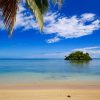Samoa Travel Guide
Welcome to the taste2travel Samoa Travel Guide!
Date Visited: October 2018
Introduction
Talofa lava! Welcome to magical Samoa, a south Pacific paradise of intense natural beauty, which is home to turquoise lagoons, lush, emerald-coloured rainforests, towering volcanic peaks, spectacular waterfalls and some of the friendliest, kindest people you could ever hope to meet.

Located on the Cross Island road, the incredible Papapapaitai falls plunge 100 metres into a lush ravine.
Despite being a modern, developing nation, Samoa is governed by a 3,000 year-old way of life called Fa’a Samoa (the Samoan Way) which is adhered to by all and has, at its core, a deep respect for family, elders (Chiefs) and the church.
This traditional way of life also includes the ‘welcoming’ of visitors and, without exception, I found the Samoans to be genuinely friendly and very welcoming – it was a pleasure spending time among them.

A typical east coast view on Savai’i with lava stones in the foreground.
As a destination, Samoa offers two very different islands which, thanks to a frequent car ferry service, can easily be explored with a hire car. The main island of Upolu is home to three-quarters of the population, the capital Apia and the International Airport.
The second island, Savai’i is larger in area but sparsely populated and features some incredible volcanic landscapes. Both islands feature a single ring road which follows the dazzling coastline, while Upolu also offers a few cross-island roads which traverse the lofty, rain-forested interior.

One of the many Alofaaga blowhole’s on Savai’i island.
On both islands, you’ll find stunning, white-sand beaches, blowholes, cascading waterfalls, hiking trails, lush volcanic peaks and even a rainforest canopy walkway.
And the award for “prettiest villages in the South Pacific” goes to – Samoa!


The immaculately-kept village of Safua on Savai’i island is typical of villages elsewhere on Samoa.
Thanks to a government-run competition, villages throughout Samoa compete against each other to be recognised as the ‘most beautiful village in Samoa’.

Painted coconuts stand like sentinels along the roadside through a village on Upolu island.
As you pass through different villages, you’re treated to the sight of incredibly manicured roadside gardens which are decorated with colourfully painted objects such as coconuts, stones, car tyres, bamboo poles and more.
The displays are incredibly beautiful and make for very pleasant driving and it’s an idea which should be introduced in other countries around the world.

Samoans love gardening and take great care with the appearance of their houses and villages.
Location
Apia, Samoa
Samoa is located in the centre of the South Pacific, west of the International Date Line and south of the equator. Its closest neighbour is American Samoa which lies 125 km (78 miles) to the east, across the International Date Line.

A view from the east coast of Savai’i island, with the larger Upolu Island in the background.
Tiny Tokelau lies 500 km to the north; New Zealand, 2,888 km (1795 miles) to the southwest; Tonga, 898 km (558 miles) to the south; Tuvalu, 1553 km (965 mi) to the northwest; Australia, 4,077 km (2,533 mi) southwest; French Polynesia 2,469 km (1,534 mi) southeast while the US West Coast is 7,797 km (4,844 mi) to the northeast.
The International Date Line
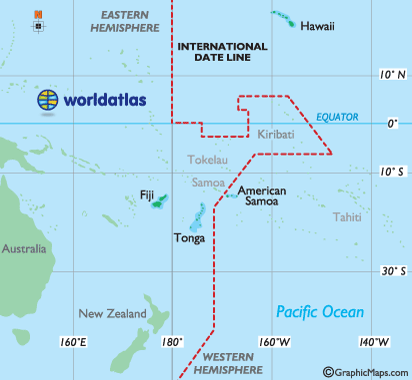
The International Date Line separates the two Samoa’s.
Source: https://www.worldatlas.com
The joys of time travel, flying east from today into yesterday and west from today into tomorrow…..
When it’s noon on Monday in Samoa, it’s 11 am on Sunday in neighbouring American Samoa, a time difference of 23 hours.
The two Samoa’s have not always been on different sides of the International Date Line (IDL). Up until the 29th of December 2011, they both sat in the last time zone, directly to the east of the IDL. It wasn’t until midnight on that day that Samoa jumped westwards across the International Date Line, losing the entire day of December 30, arriving into December 31st.

Samoa stamp issue commemorating the change of time zone.
The reason for the change? It was all about economics! Samoa made the change in a bid to improve ties with major trade partners Australia and New Zealand. Prior to the change, Samoa had been 23 hours behind Auckland – but following the change, it was one hour ahead. Previously, the country shared three business days with its two trading partners, however, following the change, that increased to a full trading week.
A Tale of Two Samoa’s

An old German map of Samoa which is on display at the Museum of Samoa in Apia.
Once upon a time… there was one Samoa, where everyone lived happily together, sharing the same language, culture, traditions and beliefs.
Then in the 18th century, the first European explorers arrived – but than continued on their way. It wasn’t until the late 19th century that the Europeans (and the United States) really became interested in Samoa with Great Britain, Germany and the United States all claiming parts of the Kingdom of Samoa, and establishing trade posts.
In 1886, Samoa entered a period of Civil war which lasted until 1894 and was fought mainly between rival Samoan factions. A 2nd Civil war reached a head in 1898 when Germany, Great Britain and the United States disputed over who should control the Samoan Islands.
To conclude the war, the Samoa Tripartite Convention of 1899, was convened between the United States, Great Britain and Germany and resulted in the partition of the Samoan islands into German Samoa and American Samoa. All of this was apparently done without consulting the Samoans. German Samoa was later renamed to Western Samoa which was then renamed to Samoa in July of 1997.
People

A map of the Polynesian Triangle.
Source: Wikipedia.
Almost all Samoans are ethnically Polynesians. It is believed Samoa was settled by Polynesian settlers around 3,000 years ago, after they had made their way across the Pacific during a centuries-long island hopping expedition. This migration resulted in a large triangular area of the Pacific being settled by Polynesians, an area which is today referred to as the ‘Polynesian Triangle‘.

The Samoans will normally greet you with a warm, friendly smile.
According to the 2016 census, the population of Samoa was 194,320 with 92.6% being Polynesian and the remainder being Euronesians, a mix of Polynesian and European.

Almost all Samoans are Polynesians and are some of the nicest people you could ever hope to meet.
Flag

The flag of Samoa.
The flag of Samoa features a red rectangle which is a traditional Samoan colour and is said to represent ‘courage‘.

The flag of Samoa displayed at the Museum of Samoa in Apia.
In the upper-left corner, a blue rectangle, which represents freedom, bears four white larger five-pointed stars and one smaller star, which represent the Southern Cross constellation.

The Samoan flag as a floral arrangement at the Sheraton Beach Resort.
Currency & Costs

Samoan 5 and 10 Tala bank notes – front view.
Currency
The currency of Samoa is the Tālā ($), which trades under the international currency code of WST (a legacy from the days when the country was known as ‘Western Samoa’). The tālā is divided into 100 sene.

Samoan 5 and 10 Tala bank notes – rear view.
The tālā ($) is issued by the Central Bank of Samoa with bank notes in denominations of $5, $10, $20, $50 and $100. The current series of notes were introduced in 2008 and are produced by Thomas De La Rue in the UK. Coins are issued in denominations of 10, 20, 50 sene and 1 and 2 tālā.
Click to view current exchange rates:
Numismatics

The commemorative 10 Tala bank note, issued to celebrate Samoa’s hosting of the 2019 Pacific Games.
Source: Thomas De La Rue
For collectors who wish to purchase uncirculated bank notes and coins, the Central Bank of Samoa website includes an online currency shop.
In 2019, the Central Bank issued a commemorative $10 bank note to celebrate Samoa’s hosting of the 2019 Pacific Games. The note was printed by Thomas De La Rue, who have provided currency to the bank for more than 40 years.
To mark the occasion, De La Rue published an article – The Art of Designing a Banknote – which explains the process behind designing a commemorative bank note.

Samoan 10 Tala notes.
Costs
Samoa is not the cheapest of destinations with a rough daily budget being:
- Backpacker: WST$250 (US$95)
- Flashpacker: WST$250 – $1000 (US$95 – US$400)
- Top End: WST$1000 + (US$400 +)
Some sample costs:

There are many excellent cafes in Apia.
- Dorm room at ‘Olivia’s Guest House’ in Apia: WST$30
- Room at the mid-range ‘Talofa Inn’ in Apia: WST$200
- Room at the Top End ‘Sheraton’ in Apia: WST$500
- Can of Coca Cola (.33l): WST$2.30
- Bottle of local mineral water (.33l): WST$2.00
- Cappuccino/ Flat White: WST$10
- Pint of Vailima (domestic) Beer: WST$4.20
- Combo meal at McDonald’s in Apia: WST$20
- Meal in a cheap restaurant: WST$20
- Meal in a mid-range restaurant: WST$25-50
- Daily car rental: WST$100 +
Philately

The ‘Buses in Samoa’ stamp issue featured the much-loved iconic public buses.
The postage stamps of Samoa are popular among philatelists around the world and can be purchased direct from the General Post Office (GPO) in downtown Apia or online from the Samoa Post website.

Some of the first stamps issued in Samoa on display at the Samoa museum.
Sightseeing
Upolu Island
Apia
With a population of 35,700 – Apia is the capital and largest city of Samoa. While most visitors to this south Pacific paradise come for the beautiful beaches (of which there are none in Apia), the capital does offer several markets, many fine accommodation options, cafes, restaurants, bars and some good shopping.
The longest drive from Apia, to Lalomanu beach, takes just 1 hour and 24 minutes, making Apia a handy base for visitors with their own wheels.
Apia Town Clock

During my visit, the iconic Apia Town Clock changed colour overnight, from a subdued pink to a bright white.
Marking the centre of downtown, the Apia Town Clock was built and gifted to the Samoan people in the 1920’s by Ta’isi Olaf Nelson. It was erected as a memorial for his son, who had died in the 1918 influenza epidemic that claimed the lives of nearly 9000 Samoans. During my visit the Town Clock incredibly changed colour overnight.
Immaculate Conception Cathedral

The imposing exterior of the Immaculate Conception Cathedral dominates the skyline of Apia.
A short walk along the waterfront from the Town Clock, the Immaculate Conception Cathedral looms large over the harbour. While imposing from the outside, the lofty, ornate interior of the cathedral is breath-taking.
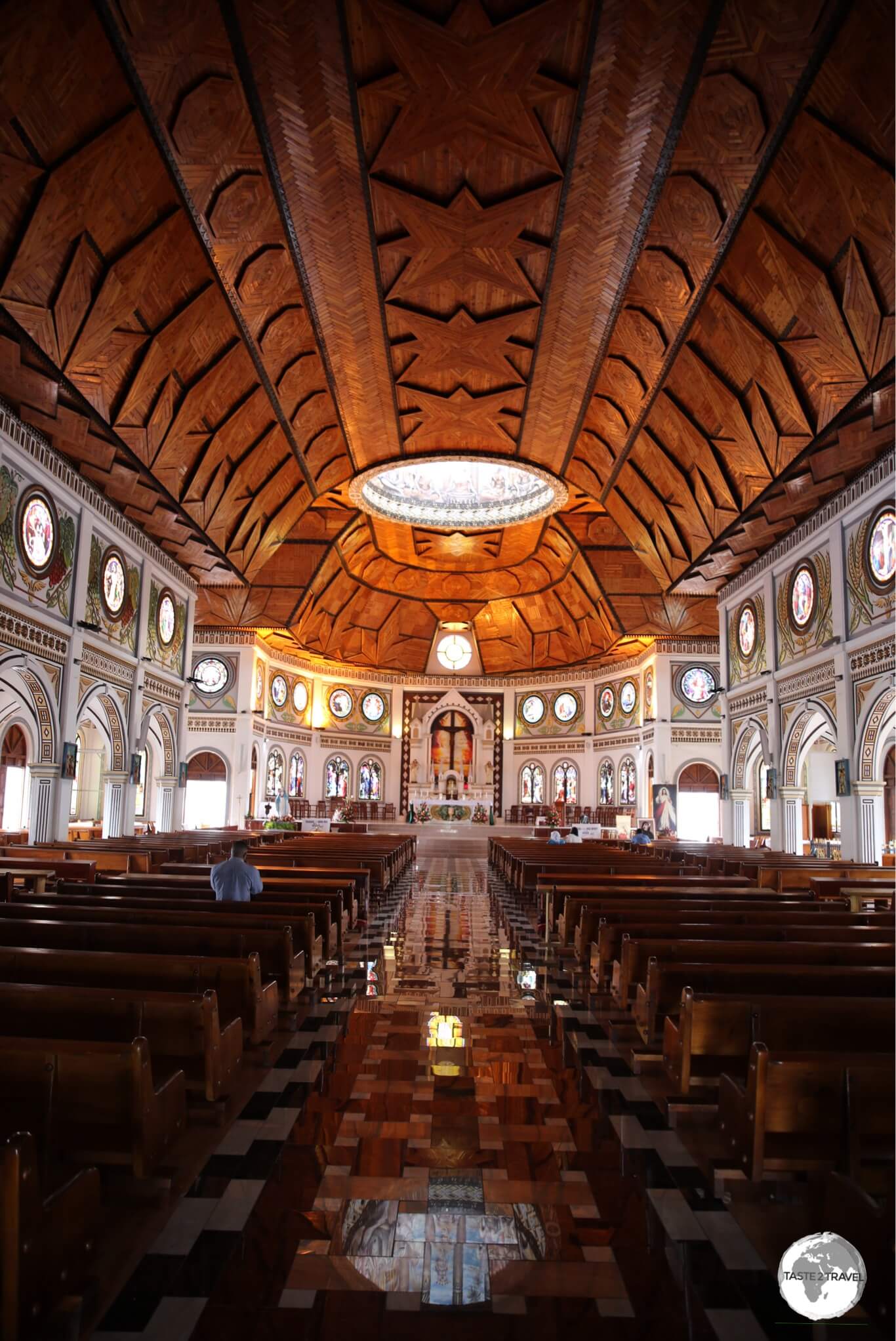
The striking interior of the Immaculate Conception Cathedral, which can accommodate 2,000 worshippers.
Originally constructed in 1884, the cathedral was rebuilt in 2013 at an estimated cost of WST$13 million, which included the installation of an ornate timber ceiling and dazzling stained-glass windows which represent the ‘Stations of the Cross’.

The artwork in the central dome of the Immaculate Conception Cathedral combines European and Samoan influences.
The central dome features a painting of the Virgin Mary seated with the apostles. Mary is shown dressed as a Samoan Matei or high chieftain seated with a kava bowl before her. The apostles are also in traditional Samoan Matai dress.
Apia Court House

One of the last vestiges of the German Colonial era – the Old German Courthouse in Apia.
Located on the waterfront, one block east of cathedral, the rambling, Old German Courthouse was designed and built in 1902, opened in 1903, and was the original seat of German power in Samoa.
When Samoa was annexed by New Zealand in 1914, the Germans were replaced with Crown-appointed administrators who then extended the original building to its current size.
Following independence, the German Courthouse was still in use until a new courthouse opened in 2010. Since then, the court house has stood empty. In a city where almost all colonial buildings have been demolished to make way for modern eye-sores, the courthouse should be heritage listed and protected, however its fate remains uncertain.
Fugalei Market
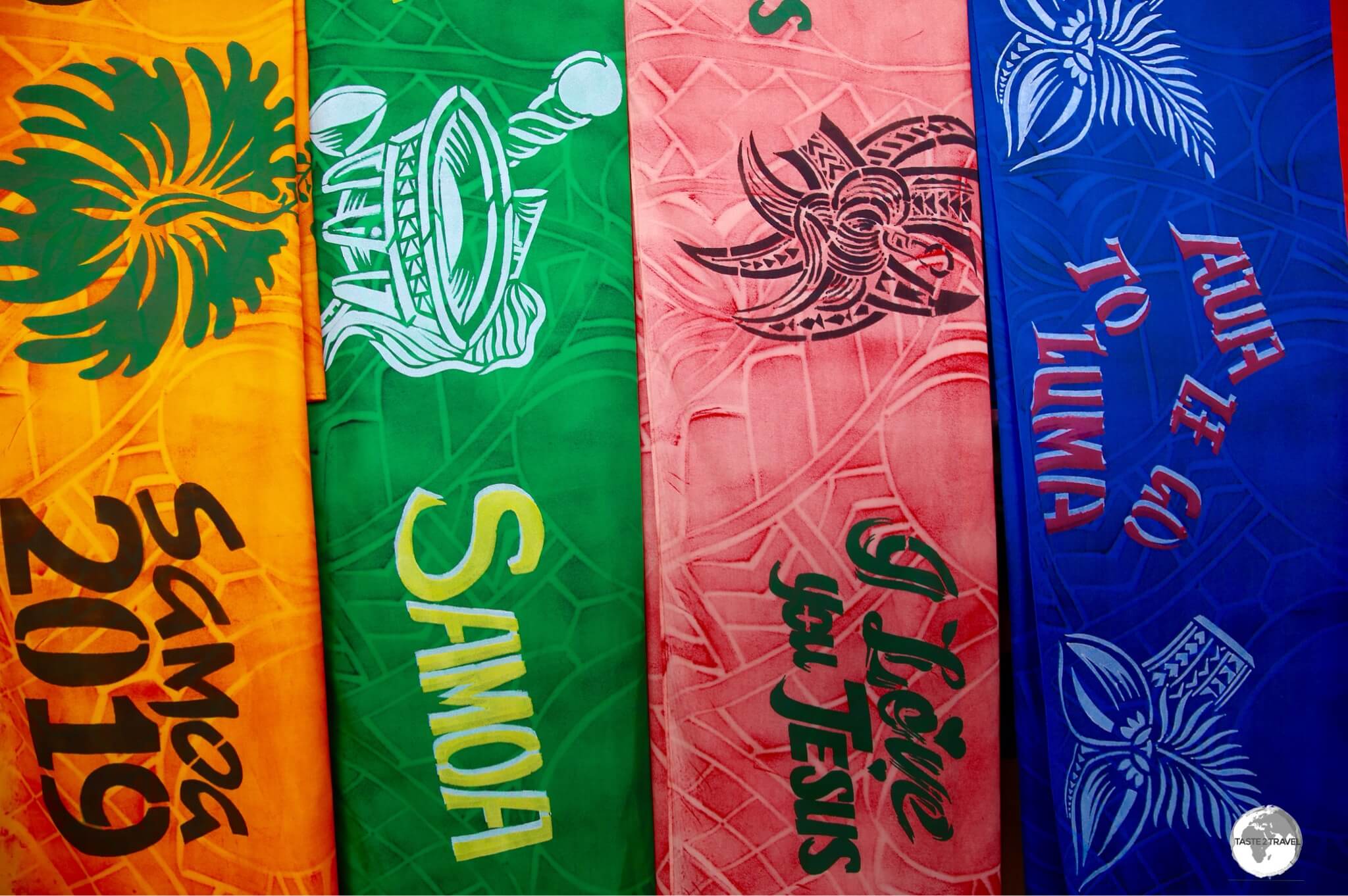
Souvenir Lava-lava’s on sale at the Fugalei market.
Located a few blocks inland on Fugalei road, Fugalei market is the central market in Apia – an open, breezy market selling fruit, vegetables, handicrafts, flowers and much more.

Flower seller at Apia’s Fugalei market.
Museum of Samoa

The Museum of Samoa is housed in an old school building in Apia.
Located on Viatele street, and open from Monday to Friday, the Museum of Samoa occupies an old German school building and features four small exhibition rooms which provide displays detailing the history and culture of Samoa.
The well-designed displays are informative and are a good starting point for those who wish to gain some knowledge of the country. ell designed
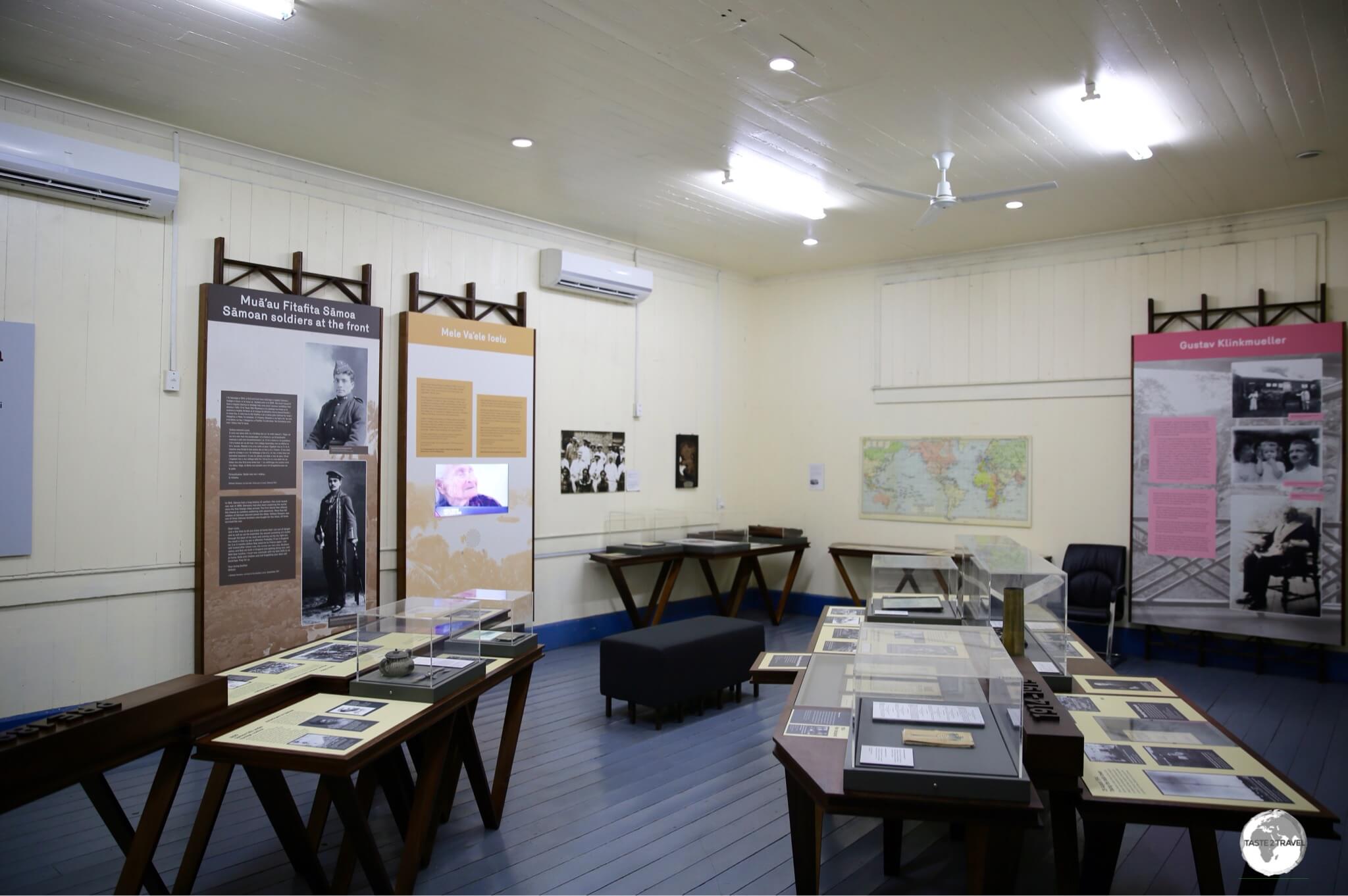
One of the four exhibition rooms at the Museum of Samoa.
One of the more interesting items on display is the ‘Cabinet Meeting Table‘ which was formerly installed at the Parliament house. Constructed in 1973, the table was built using seventeen different species of native wood. It breaks down into six separate pieces and contains no fixings.

The ‘Cabinet Meeting Table’ has played a long role in Samoan politics and features seventeen different species of native Samoan wood.
Outside Apia – Cross Island Road
Note: the following list of sights follows a journey travelling anti-clockwise around the eastern half of Upolu island.
Mailelani Samoa

Wrapping fragrant soap at Mailelani Samoa.
From the museum, if you continue up the Cross Island road to the village of Papauta, you’ll reach a signposted side street which leads to the Mailelani Samoa factory. The company is owned by a Samoan/ Swiss, husband (Kitiona) and wife (Sylvie) team, and produces a small range of products using local coconut oil. For visiting Swiss, Sylvie serves as the Swiss Honorary Consul for Samoa.

Mailelani Samoa soap direct from the factory.
The products from Mailelani (which means ‘from heaven’) can be found in stores and supermarkets all over the island, but there’s nothing like a factory tour to gain a better understanding of these fine products. The company currently produces soaps and moisturisers which are scented with local fragrances. My favourite is their Frangipani body lotion.

Products for sale at the Meilelani Samoa factory shop.
In addition to the factory tour, there is a gift shop where you can purchase products plus a small cafe is due to open soon. For those who appreciate funky art, the factory walls are adorned with interesting artworks.

Pineapple artwork at the Meilelani Samoa factory.
Robert Louis Stevenson Museum

Villa Vailima was built by Robert Louis Stevenson and served as his residence until his untimely death.
Continuing a short distance up the Cross Island road from Meilelani Samoa, you’ll reach the stately ‘Villa Vailima‘, the former estate of Scottish author Robert Louis Stevenson (RLS).

The interior of Villa Vailima, the former residence of Robert Louis Stevenson.
Stevenson purchased the land in 1889 for US$4,000 and had the villa built. A few years later, on the 3rd of December 1894, Stevenson died suddenly from a brain haemorrhage at the age of 44. As per his request, he was buried on the adjacent Mount Vaea.

Staff at Villa Vailima singing poetry written by Robert Louis Stevenson.
Access to the villa is via a half-hour tour that leads through rooms lined with Tapa wallpaper and filled with antiques and old family photographs. The tour ends with all the museum guides singing the verse which is inscribed on the tomb of RLS.

This richly decorated room at Villa Vailima felt like a set from a Ralph Lauren catalogue photo shoot.
Mount Vaea National Reserve

The tomb of Robert Louis Stevenson lies on the summit of Mount Vaea, overlooking Apia and the Pacific Ocean.
Next to Villa Vailima, Mount Vaea is the burial site of RLS who had two wishes; to be buried on the top of Mount Vaea and to be buried with his boots on as he used those boots to walk on the Samoan lands. The following verse is inscribed on his tomb:

The plaque on the tomb of Robert Louis Stevenson on Mount Vaea.
With an elevation of 472 m, Mount Vaea is the oldest volcano on Upolu. There are two walking trails which provide access to the tomb site; a short loop and a long loop.

The panoramic view over Apia and the Pacific Ocean from Mount Vaea.
The short loop runs for 800 metres and involves climbing a continuous set of steps. In the tropical heat and humidity, this is a true workout and best tackled on the descent. The long loop track is a more gradual climb but 3x longer.

While climbing Mount Vaea I saw many Samoan black Skinks along the trail.
Baha’i Temple of Samoa
Continuing further up the hill from Villa Vailima, on the Cross Island road, the spectacular Baha’i Temple of Samoa is one of only eight in the world and the only one on any of the Pacific islands.

The gardens and temple at the Baha’i Temple.
The temple is surrounding by a large formal (European style) garden which is well set out with tropical plants. The garden is beautifully maintained by a team of 5 full-time gardeners. It’s a relaxing place to wander and spend some time.

The striking interior of the Baha’i Temple.
An information centre provides information for those who are interested in learning more and the, architecturally interesting, temple is open to all visitors.
Papapapaitai Falls
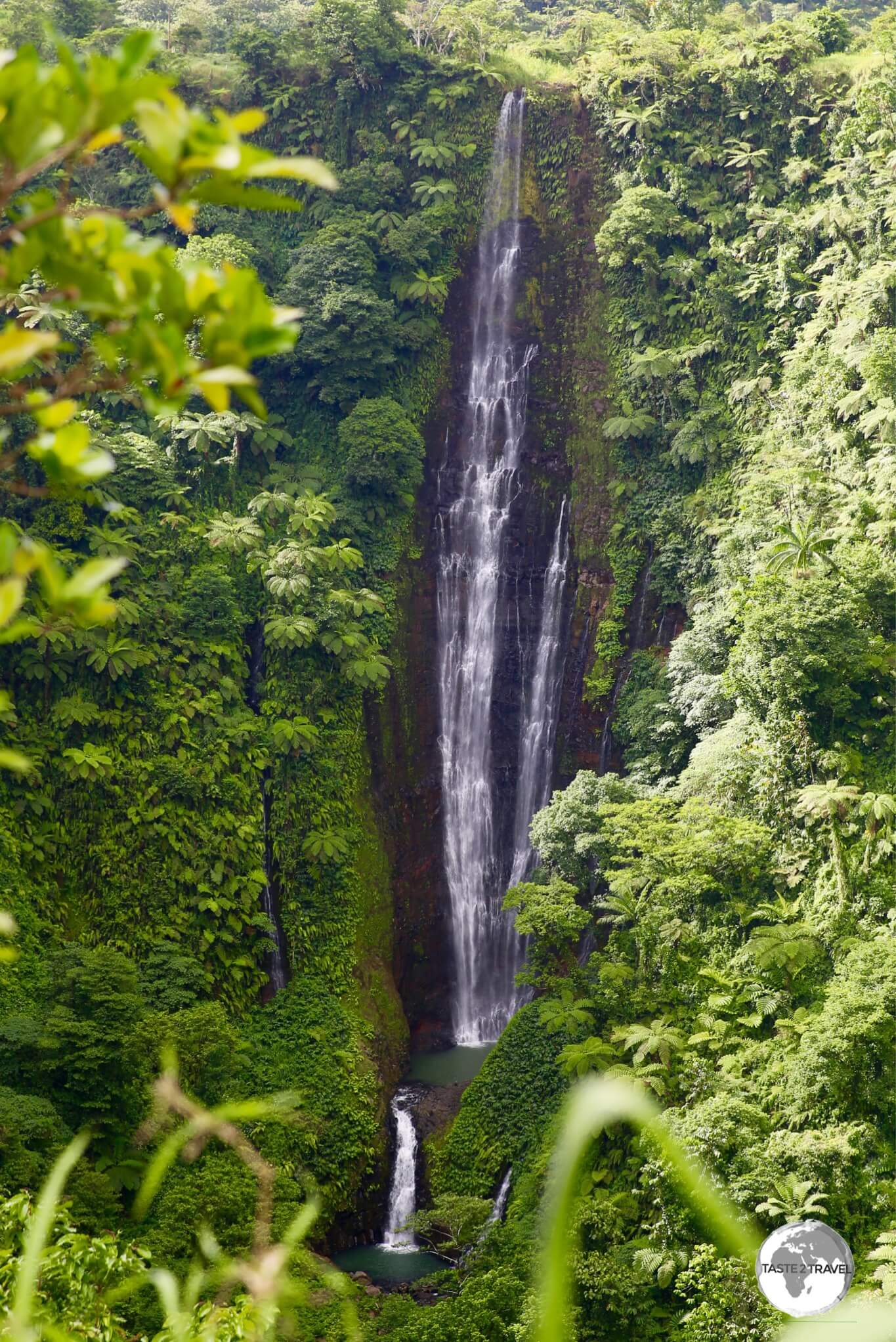
The 100-metre high Papapapaitai Falls.
Continuing on the Cross Island road, over the hill from the Baha’i Temple, the road starts its descent to the south coast, eventually reaching a vantage point from where you have a spectacular view of the incredible Papapapaitai Falls. At 100 m in height, the falls are the referred to as the longest waterfall in Samoa.
Upolu South Coast
After the Papapapaitai Falls, the Cross Island road meets the South Coast road. A left-hand turn leads to a number of fantastic sights, the first of which is Togitogiga Waterfall.
Togitogiga Waterfall

Surrounded by lush vegetation, the Togitogiga Waterfalls are a popular swimming hole.
Located near the village of Saleilua, a swimming hole separates the cascading Togitogiga Waterfall which is a popular destination for local families. Unlike most other places in Samoa, there was no one demanding money to access this refreshing attraction.

A Samoan family enjoying a swim at the Togitogiga Waterfalls.
To Sua Ocean Trench & Blow Holes
Continuing further east along the South Coast road from Togitogiga Waterfall, you’ll eventually reach a truly spectacular sight, the amazing To Sua Ocean Trench (WST$20) – possibly the World’s most spectacular swimming hole.

Formed during an ancient volcanic eruption, To Sua is a spectacular sight.
To Sua, formed during an ancient lava eruption when the land around it slipped away, consists of two large holes joined by a lava tube cave. The main hole – the pool – is filled with seawater and is connected to the ocean by an underwater cave. The flow of water in the pool ebbs and flows along with the ocean swells, which are just metres away on the other side of the cave wall.
The lush green rock walls of To Sua drop 20 metres to the turquoise-blue waters of the magnificent pool below. Swimming access is via a precipitous but sturdy wooden ladder which can be slippery when wet.

The 20-metre long, slippery, wooden ladder which descends into To Sua can be a confronting experience for anyone who is afraid of heights.
To Sua is a highlight of any trip to Samoa and is incredibly photogenic. If you want the best photos, you should plan to be at the trench around lunchtime when the sun is directly overhead. Any other time of day, the swimming hole is in shadow (such as my photos which were taken mid-afternoon).

A blowhole on the beach in front of To Sua.
The dramatic coastline in front of To Sua has been shaped by past volcanic activity which has left lava tubes, lava flows and blow holes.
Lalomanu Beach
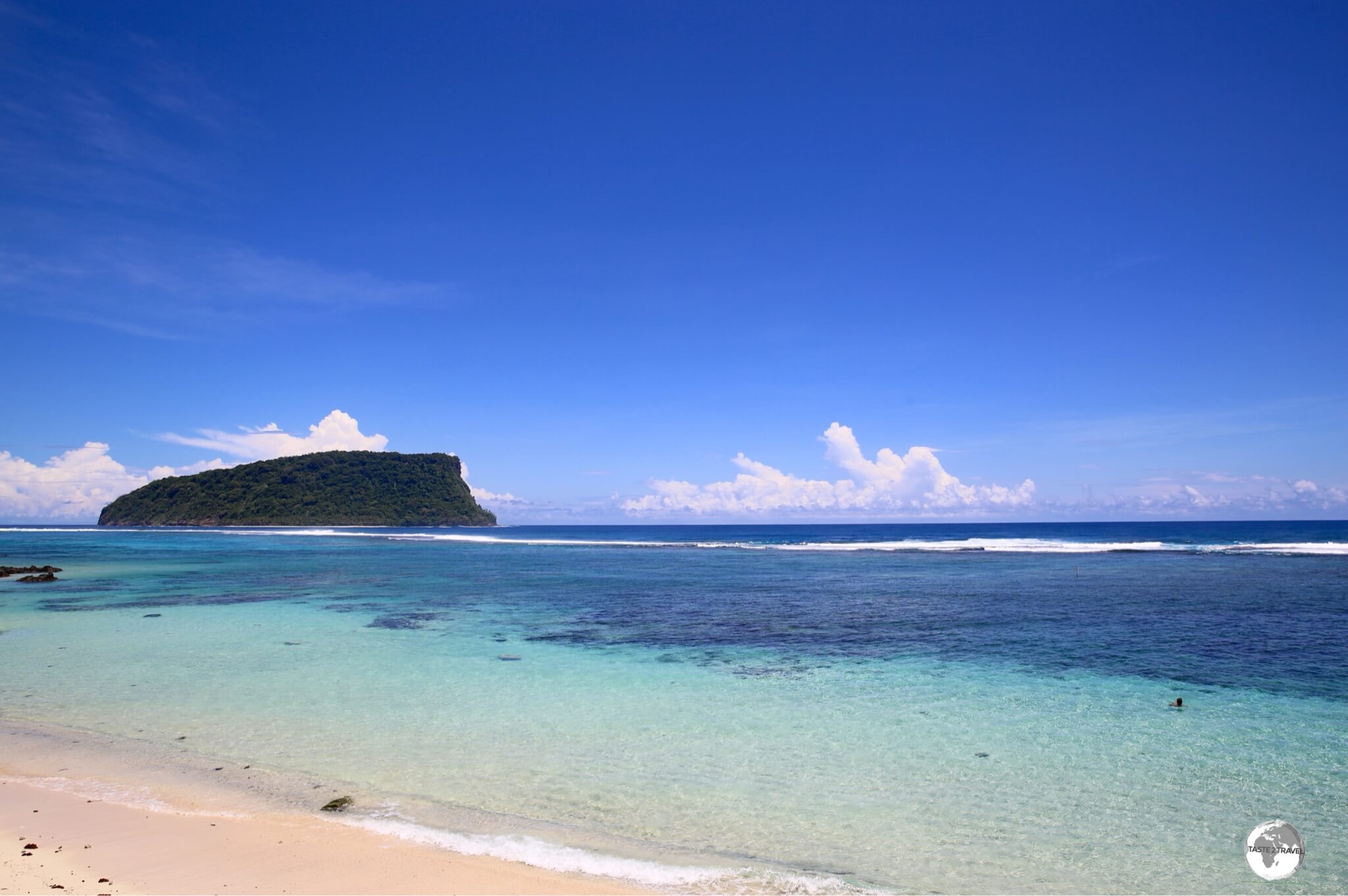
A view of the Lalomanu Beach, one of the finest south coast beaches.
Located at the south-east corner of Upolu, Lalomanu Beach is one of the more beautiful beaches in Samoa. If you’re backpacking, you’ll find plenty of budget friendly, seaside fales strung out along the main road. If you’re flash-packing, I recommend the Litia Sini resort which offers comfortable fales and incredible food in their terrace restaurant which overlooks the beach.

The amazing seared-tuna which I had for lunch at Litia Sini resort.
There are several nearby offshore islands which can easily be explored. If you wish to have a Robinson Crusoe experience, Namuá Beach Fales offers basic (open-air fales) accommodation, without any electricity, on the island of Namuá.
Upolu East Coast
After Lalomanu Beach, the main road swings left and starts its short journey along the east coast of Upolu.
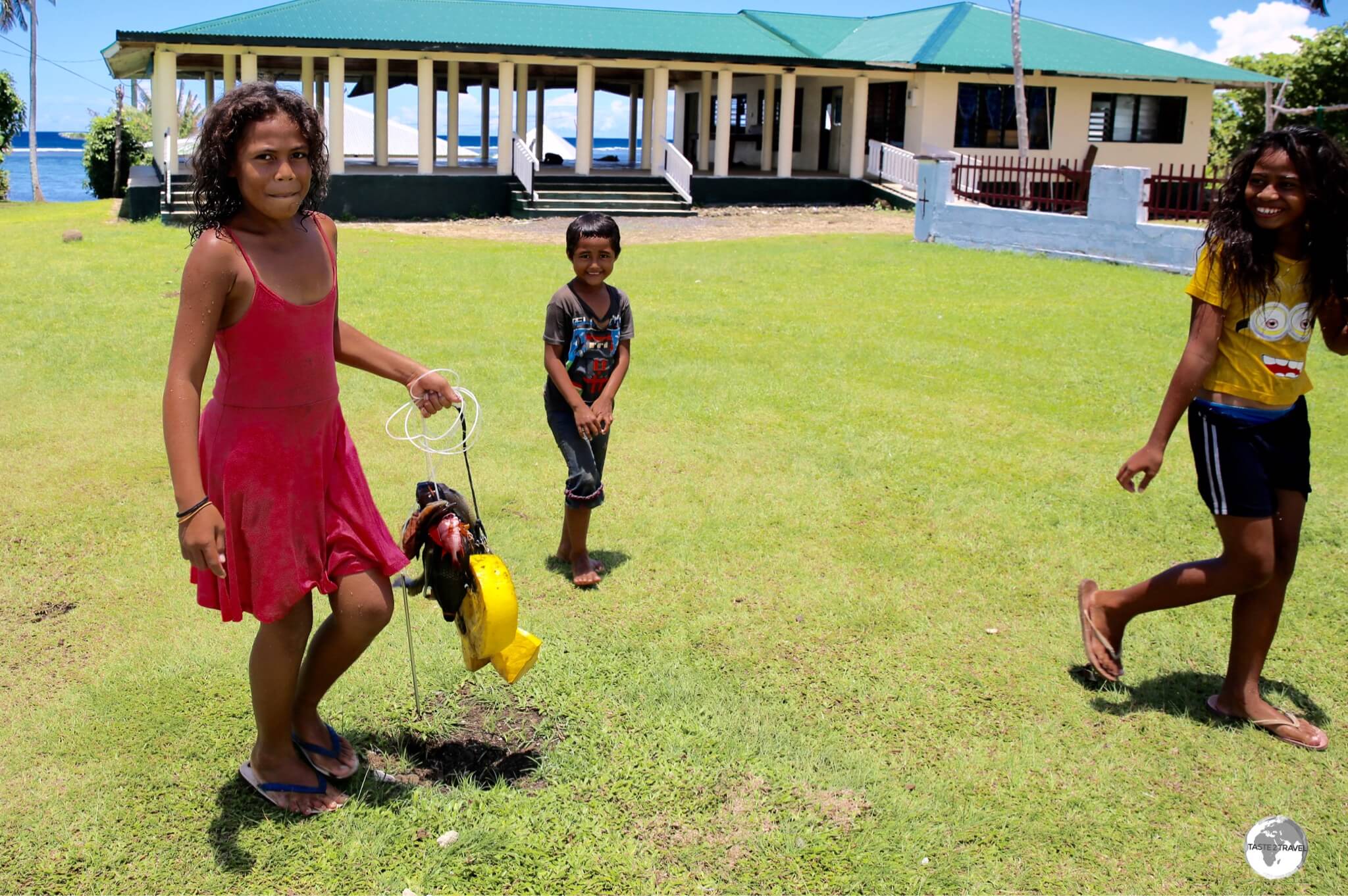
Children in Amaile returning home with the catch of the day.
In the tiny village of Amaile, the road comes to an end in front of a church. From the church, a small track leads down to the coast to the hidden Vaiole Tama Spring.

Located in Amaile village, Vaiole Tama Spring is fed by a source hidden inside a coastal cave.
Beyond Amaile, the South Coast road becomes Richardson road, which cuts a path due west, through the lush interior of the island.
Falefa Waterfalls

The impressively powerful Falefa Waterfalls.
Located near the north coast, where Richardson road meets the Main East Coast road, these thundering falls (WST$5) are best visited after a period of heavy rainfall. The nominal fee which is charged by the landowners gives you access to a short walking trail which leads through a well-maintained, tropical garden down to the falls.
Detour: The road to Saletele…

Magnificent view along the coast to the village of Saletele.
A side road which crosses the Falefa Waterfalls leads to the distant village of Saletele. While the destination is a sleepy fishing village, the journey there is remarkably scenic, following a high road along the coast line, passing cascading waterfalls and offering a glimpse of the rural side of Samoa.

A villager from Saletele returning home with freshly picked bananas.
Upolu North Coast
Piula Cave Pool

The pristine, crystal-clear spring water of the Piula cave pool.
Continuing along the north coast, back towards Apia, the Piula Cave Pool (WST$10) is a natural freshwater pool by the sea which is very similar to the Vaiole Tama Spring in Amaile. The source of the spring water lies within a coastal cave beneath the historic Methodist chapel at Piula.
Savai’i Island

Many homes on Savai’i are built on volcanic lava flows.
Although Savai’i is the larger of the two Samoan islands, it has a far smaller population and offers a more relaxed sightseeing schedule. The island has been formed from volcanic activity, some of it as recently at 1905.

The east coast of Savai’i Island.
Savai’i East Coast

Palm trees line the shoreline of the dazzling lagoon on the east coast of Savai’i.
The quiet east coast of Savai’i is characterised by small fishing villages which overlook the stunning turquoise-blue lagoon.

A typical east coast view on Savai’i with lava stones in the foreground.
Savai’i North Coast
Manase

The dazzling-blue waters around Manase are rich in marine life, including turtles.
The north coast village of Manase is home to a nice stretch of white sand beach and numerous accommodation options (refer to the ‘Accommodation‘ section below for more details).

The azure waters of Manase beach.
The brilliant blue colour of the water is the result of the mixing of saltwater and freshwater, the freshwater being delivered into the ocean via underground lava tubes. The snorkeling off the beach is amazing, with lots of coral, marine life and ample seagrass which attracts feeding turtles.
Peapea Cave

Exploring Peapea Cave, which is a 1-km long lava tube, with my guide Mati.
West of Manase, you have the opportunity to explore two fascinating Lava tubes, the first of which is Peapea Cave, which sits beside the main road just south of the village of Letui.

The custodian of Peapea cave, and my guide, Mati, at the entrance to the lava tube.
Like everything else on Samoa, an entrance fee (WST$5) needs to be paid to the landowner – Mati – who will provide a torch and a short guided tour.
Apparently the lava tube is 1-km in length, although the tour with Mati lasts just 15 minutes which is long enough to disturb the hundreds of nesting swiftlets who inhabit the cave.
A’opo Lava Tube

The entrance to the much larger, A’opo Lava Tube.
Continuing further west along the main road, you’ll soon reach the A’opo Forest Reserve and Lava Tube. This lava tube is much bigger and longer than Peapea and is accessed via a 15 minute walk through the forest.

My guide, Lagi, inside the A’opo Lava Tube.
I was escorted by Lagi, a family member, who told me that many years ago, when the tube was first discovered, the village chief had set off with a small team to find the outlet of the tube. They returned 10 hours later not having reached the end.
The coast is a 5-hour, downhill walk from the property, it is believed the tube empties into the sea. Either way, this lava tube is impressive and what makes it more incredible is that you have the place to yourself.

Lagi carefully selects my pineapple from the family plantation. It was delicious!
While passing through the forest, I past mango trees full of ripe mangoes, banana trees and a large pineapple plantation. I was able to select my own pineapple for which I paid a small fee, it was very sweet!
How does a Lava Tube form?

Lava Tube life-cycle.
Source: US Geological service.
Lava typically travels in channels away from the point of eruption. As the molten lava flows, the rock beneath the lava flow heats and can melt, while the surface of the molten lava tends to cool. Many times the top of the channel will cool enough to completely harden, while the lava continues to flow through this “tube” beneath the surface. Thus, a lava tube in born.
Vaisala Beach

Storm clouds form over Vaisala beach.
The sandy beach at Vaisala is home to a couple of accommodation options, one of which is the popular Vaisala Beach hotel (refer to the ‘Accommodation‘ section below for more details).

Vaisala beach on the north coast of Savai’i.
Canopy Walkway

Suspended 40-metres above the rainforest floor, the shaky Canopy Walkway is unique in Samoa and can be challenging for those with a fear of heights.
One of the highlights of a visit to Savai’i, and a challenge for those trying to overcome their fear of heights, is the rickety Canopy Walkway. The walkway has been constructed by the local villagers in the middle of the Falealupo Rainforest Preserve from wires and aluminium ladders (they form the base).
Suspended between two giant Banyan trees, 40 metres above the forest floor, the 30 metre traverse offers a panoramic view of the surrounding trees. Entrance to the walkway costs WST$20 which also provides entrance to two other nearby attractions.
Falealupo Catholic Church

Falealupo Catholic Church was destroyed by the massive waves of cyclone Ofa in 1990.
A short drive north from the canopy walkway in the coastal settlement of Falealupo, stands the eerily quiet, beachside ruins of the former Falealupo Catholic Church which was destroyed by the massive waves of cyclone Ofa in 1990.
Also destroyed was the village of Falealupo, with villagers forced to swim to the safety of the nearby Falealupo Primary School which is built on higher ground.
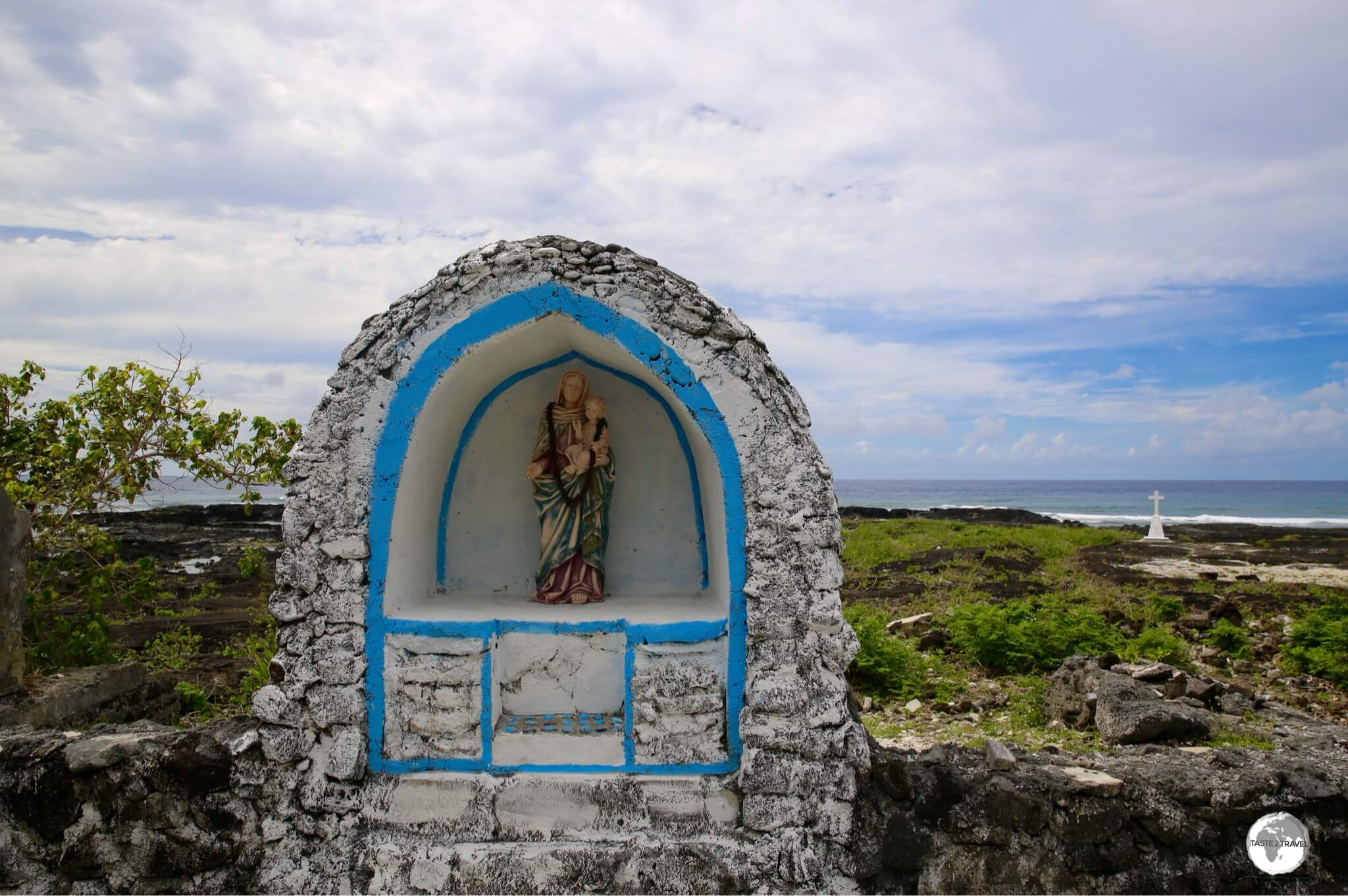
The former interior of Falealupo Catholic Church.
Falealupo Beach
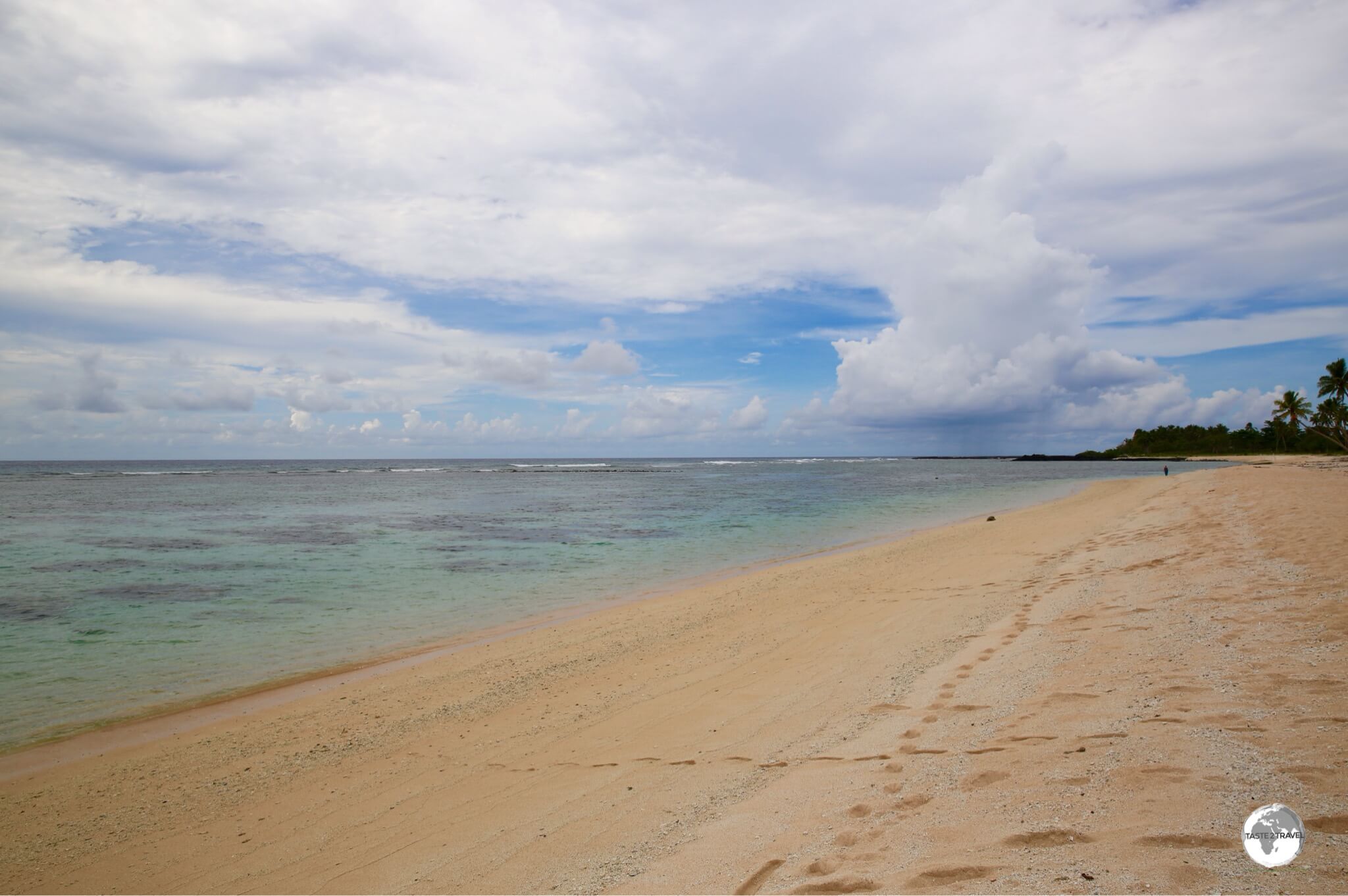
Falealupo Beach is one of the finer beaches on Savai’i.
The very remote Falealupo Beach lies at the most western point in Samoa, offering a wide strip of powdery sand and beachside fales (refer to the ‘Accommodation‘ section below for more details).
Savai’i West Coast
Most of the west coast of Savai’i is comprised of volcanic cliffs with a handful of beaches. The main road travels slightly inland from the coast.
Savai’i South Coast
Like the west coast, the south coast of Savai’i is mainly volcanic cliffs with a few isolated beaches.
Alofaaga Blowholes

A photo sequence showing the lifecycle of a Alofaaga blowhole.
Located in the south-west corner of Savai’i, near to the village of Taga, the spectacular Alofaaga Blowholes (WST$5) exist thanks to underground lava tubes which were created during previous volcanic eruptions.
Waves breaking against the lower end of the tubes send water at high pressure up through the tubes, creating fountains that spray every few seconds.

One of the many blowholes at Alofaaga.
There are numerous blow holes along the rocky cliffs. The area is unfenced and unattended so you can get a close to the action as you wish, but the rocks can be slippery and any fall (into the holes) would probably be fatal.

Ancient lava flows cover the beach around the Alofaaga blowholes.
Accommodation
Upolu Island
There are plenty of accommodation options in Apia and many fine dining options, which makes the capital an ideal base for exploring the island with the most distant places being just over an hour away by car.
With the exception of the Sheraton group, who have two properties on the island (Sheraton Samoa Aggie Grey’s in Apia and the Sheraton Samoa Beach Resort near the Faleolo International Airport), there are none of the usual international hotel groups in Samoa. However, there are plenty of deluxe resort options available and many fine mid-range properties.
Apia Backpacker Recommendation
Located on the East Coast road, 1 km from downtown Apia, Olivia’s Accommodation offers a variety of budget rooms which are arranged around a garden courtyard. Room rates include breakfast with a dorm bed costing WST$30 per night.
Apia Mid-Range Recommendation

My ‘deluxe’ room at Talofa Inn in downtown Apia.
While on Upolu, I based myself in Apia and used a rental car to explore the island. I stayed at the spotlessly clean Talofa Inn which is an affordable bed & breakfast, located in the heart of the downtown area. If you’re looking for a home-away-from-home in Samoa, look no further than Talofa Inn.

A ‘budget’ room at Talofa Inn.
Housed on the second floor of a charming timber house, Talofa Inn offers six comfortable rooms with air-con and cable TV. Four of the rooms (doubles or twins) have ensuite bathrooms while two, smaller single rooms have their own bathrooms located down the hallway. Like everywhere else in Samoa, WiFi is available through the purchase of a voucher.

The communal kitchen at Talofa Inn.
As you spend time in Samoa, you’ll notice that everything is kept spotlessly clean. Talofa Inn is no exception, with the staff always mopping the floors, wiping down surfaces and keeping the house in an immaculate state. Rooms are thoroughly cleaned each day and there is a strict ‘no shoes’ policy inside the house.

The outdoor common area at Talofa Inn.
The small team of ladies who manage Talofa Inn are incredibly friendly and go out of their way to ensure your stay is a pleasant one. Each morning they serve a delicious and filling breakfast, which always features a traditional Samoan breakfast item. If you wish to self-cater, there’s a very clean communal kitchen available and a large supermarket across the road.

The spotlessly clean hallway at Talofa Inn.
Also across the road, you’ll find a taxi rank, barber shop and – for something completely random – a small outdoor billiards hall. If you wish to join the local Samoan craze of having your body adorned with a funky Polynesian tattoo (they are never small or discrete), you’ll find a tattoo studio across the road. It really is a ‘happening neighbourhood’. A double or twin room costs WST$200 per night.Apia Top-End Recommendation

Deluxe, waterfront villas at Taumeasina Island Resort.
If you wish to splash some serious cash on a comfortable crib while in paradise, it’s hard to beat the spacious and deluxe rooms at the Taumeasina Island Resort. Rooms start from WST$580 (USD$225), but this is a private island resort with one of the best beaches (no shallow on-shore reef) on Upolu.
Beachside Accommodation
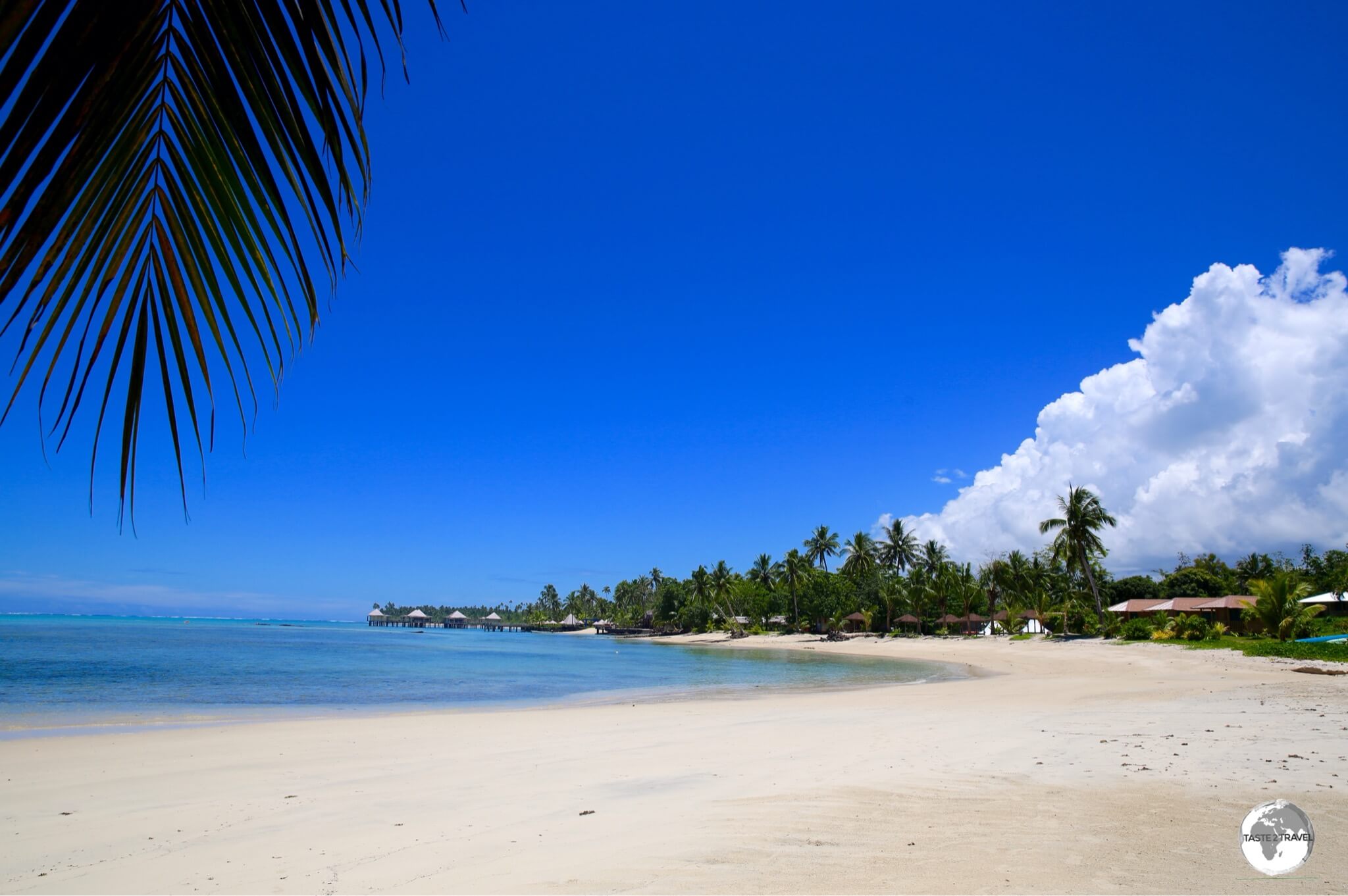
Beautiful Maninoa beach lies between Sinalei Reef Resort & Spa and Coconuts Beach Club Resort & Spa (background).
The best beaches on Upolu are on the south coast and its here you’ll find a number of beautiful resorts which provide access to powdery-white sand beaches. My favourite south coast resort is the (adults-only) Sinalei Reef Resort & Spa which has beautifully manicured gardens, a deep swimming pool and overlooks the stunning Maninoa Beach.
Savai’i Island

The dazzling waters of Manase Beach on the east coast of Savai’i Island.
The Savaiian Hotel
While on Savai’i, I stayed at the Savaiian Hotel which is located on the east coast, in the village of Lalomalava, a short drive north of the ferry terminal. Located on the waterfront (no beach), the hotel offers a pool, restaurant, bar and accommodation options for backpackers, flash-packers and those wanting something more deluxe.
Stevensons at Manase

My beautifully decorated room at Stevensons.
Located on the north coast of Savai’i, Stevensons at Manase is located on a beautiful white-sand beach which has the most dazzling blue water. The rooms at Stevensons are comfortable but there are issues, especially with the installation of fittings and plumbing as everything is installed by untrained, local, labourers.

The view from Stevensons Resort at Manase.
Vaisala Hotel

My old and tired cottage at the Vaisala Beach Hotel.
Further along the north coast, I also stayed at the budget-friendly Vaisala Hotel, which overlooks one of the better beaches on the island – Vaisala beach. The hotel is also (confusingly) known as the Vaisala Beach Hotel and also the Vaisala Beach Resort and is marked on Google maps in two different locations. The rambling timber hotel is in need of renovation, especially the rooms which are old, tired and rundown.
The hotel is owned by a significant family from Vaisala – the Vaai family. Opened in 1983 by Vaai Kolone (who was elected to serve as Prime Minister of Samoa twice in the 1980’s), the hotel was destroyed in the 1990’s by a cyclone and was rebuilt, but clearly has seen no further investment since.
Savai’i Backpacker Recommendation

Falealupo Beach Fales offers well-ventilated fales on the beach.
Located on the best beach on Savai’i, the remote and isolated Falealupo Beach Fales offer open-air, no-thrills Fales on the white-sand beach. This is a form of camping with shared bathrooms located a short walk from the Fales.
There is no security so you need to keep an eye on your belongings and there are no dining options anywhere in this part of the island so meals are prepared by the family.
Eating Out

There’s no shortage of good produce in Samoa.
Upolu Island
There are two places where you’ll find dining options on Upolu – downtown Apia and in the various resorts around the island. Samoans tend to eat at home so there’s no need for dining options outside of the capital.
The dining scene in Apia has benefited from a small army of Samoans who have returned back to their homeland from Australia, New Zealand (and elsewhere) and have bought their culinary skills with them. If you enjoy cafe life, Apia has the best cafe scene of any city in the Pacific region – outside of Australia and New Zealand, with many excellent cafes within walking distance of each other. If you enjoy cafe culture, you’ll find yourself in heaven in Apia.
Cafés
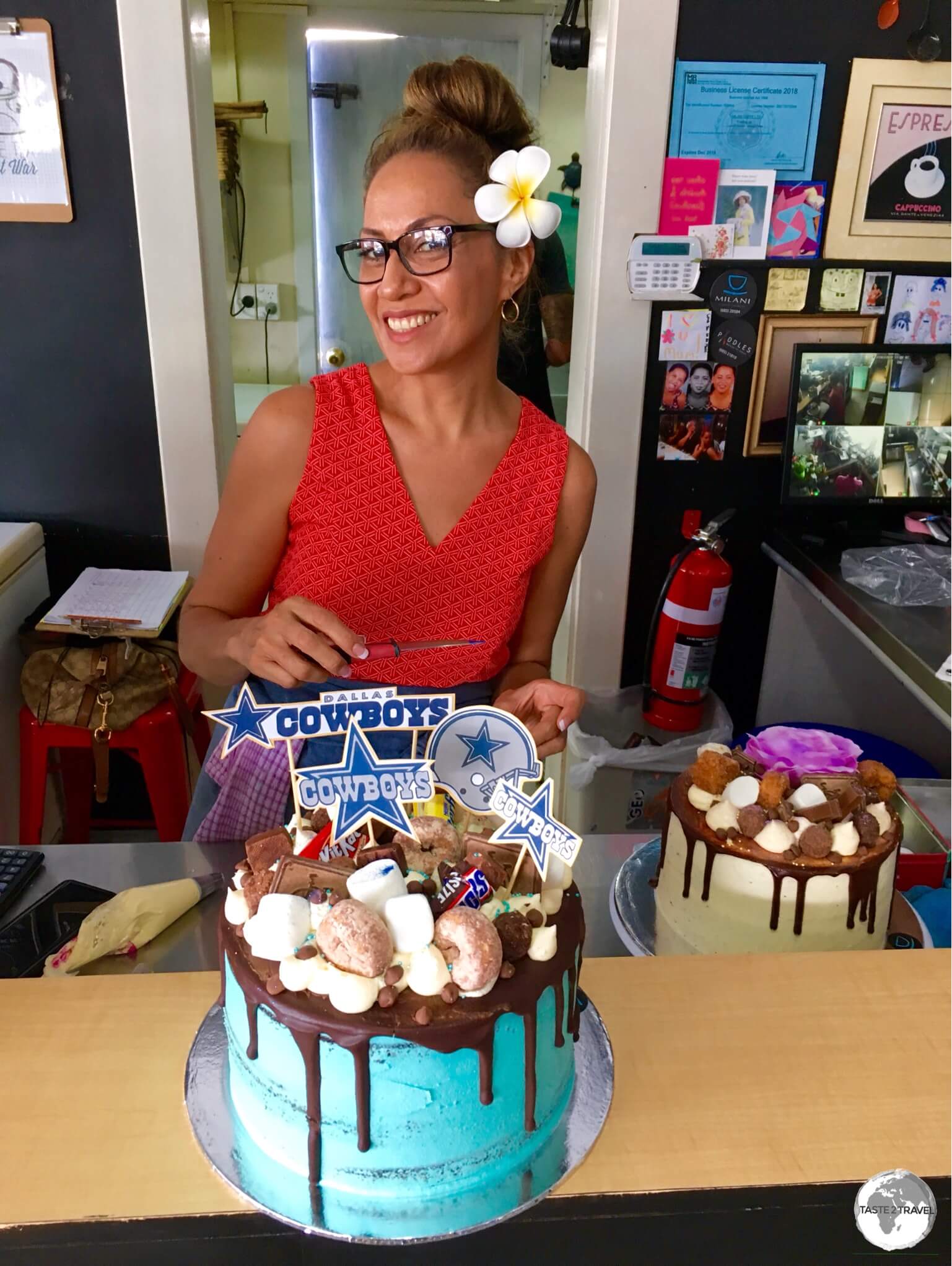
The amazing Dora of Milani Caffe putting the finishing touches on another of her amazing creations.
There are many fine cafes in Apia, with one of the best being Milani Caffe, which is owned by a Samoan/ Italian family who are also responsible for the excellent Paddles restaurant (see below).
Headed by the fabulous power-house team of Dora and Giovanni, the staff at Milani provide impeccable, attentive service – all of which starts the moment you arrive and the door is opened for you.

Made fresh everyday, Dora’s coconut & pineapple cake is the house special at Milani Caffe.
Open for breakfast and lunch from Monday to Saturday, all menu items at Milani are divine, from the freshly baked banana bread, eggs Benedict, omelettes and so much more.
The coffee is made and served with love but the real stars of the show are the freshly baked cakes, all of which are lovingly iced by Dora at the front counter. The coconut & pineapple cake is especially recommended.

Another of Dora’s amazingly fresh creations at Milani Caffe.
A short walk from Milani Caffe is the, also excellent, All Things Sweet (ATS) which offers superb coffee, amazing breakfast items and tasty smoothies made from fresh, local fruits. Living up to its name, ATS offers a tempting range of cakes and pastries and plenty of sweet breakfast items.
Looking out the cafe window, across busy Fugalei street, a white shipping container with the word TOKELAU painted on it indicates the location of the Tokelau Apia Liaison Office. For more on Tokelau, and this office, please refer to my post on Tokelau.
Located on the main street, Bean Headquarters Cafe (aka BNHQ) also offers wonderful coffee, great tasting food, good service and a wall full of photos of the groovy Samoan buses. Unlike all other cafes in town, BNHQ is open on Sunday which is great news for those in need of a caffeine fix during their day of rest.

A delicious lunch at Nourish Cafe, Vietnamese spring-rolls and a fresh coconut.
Elsewhere in Apia the, also excellent, Nourish Cafe is located next to the Cathedral on Mulivai street and like most other cafes is open for breakfast and lunch.
Yet another Apia cafe serving excellent coffee, the meals at Nourish are made from the freshest of local ingredients and beautifully presented. The cafe is the one place in town where you can buy Koko Loa chocolate, which is made from Samoan cocoa beans.

Local Koko Loa chocolate, which is made from Samoan cocoa beans.
Located on the waterfront, a short walk from Nourish and close to the Sheraton hotel, the spacious, cool and inviting Coffee Bean Cafe serves consistently fabulous coffee and amazing meals and is open longer hours than most other cafes in Apia, catering to those in need of a late-afternoon caffeine kick.
Koko Samoa

Samoan cocoa beans on sale at the market in Apia.
Just as hot chocolate is a comfort drink to people around the world, Koko Samoa is a comfort drink to Samoans everywhere. If you wish to try this local version of hot chocolate, you’ll find it available in every cafe in Apia. If you wish to make it yourself, you can do so using the following recipe.
Recipe – Koko Samoa (makes 2 cups)
Ingredients:
- 2 cups (500ml) water
- 4 tablespoons (24g) Koko Maka (grated)
- 4 tablespoons (60g) sugar
Preparation:
- Bring the water to the boil.
- Add the Koko Maka. Turn the heat down and simmer for 10-15 minutes to release the cocoa oils and flavour from the nibs.
- Turn off the heat, and sweeten with the sugar.
- Pour into drinking mugs.

Koko Maka (raw cocoa paste) is used to make Koko Samoa.
Restaurants

“One of the most amazing salads in the world” – the Salad Niçoise at Paddles restaurant.
There are many fine dining options in Apia and during my stay I had the good fortune to try many of them. Four of my favourites are listed here:
Paddles – Located on the waterfront, near the Marina, this gourmet temple is owned by the same, incredible, Italian-Samoan family who own the Milani Caffe. If you started your day with a coffee at Milani, you’ll recognise the talented Giovanni, who manages the cafe by day and serves as the maître d’ at Paddles by night. Almost all other cafe staff also moonlight at Paddles.
Offering a menu which combines the best of Italian and Samoan cuisine (plus influences from other countries), the portions are very generous, the atmosphere convivial, elegant and laid-back. I ate here more than once, with my favourite dish being their Salad Niçoise, which is served on a huge platter and includes lashings of gently seared local yellowfin tuna. I would nominate this as one of the most amazing salads in the world.
Bistro Tatau – If you’re celebrating something special or are in search of refined, fine dining, the upmarket Bistro Tatau will not disappoint. From melt-in-your-mouth sashimi to baked duck, the menu is eclectic and innovative. The barefoot waiters in lava-lava are very attentive, offering faultless service while the mood is very chilled and relaxed.
Tifaimoana Indian Restaurant – If you have a hankering for great tasting, authentic Indian food, Tifaimoana possibly offers the best Indian food in Samoa. I found one other Indian restaurant in Apia but it didn’t compare. The chef is from India and apparently sources ingredients from his homeland. I had a Chicken Tikka Masala, pilaf rice and butter naan – all of which delivered the taste sensation I was craving. The restaurant is located off Fugalei road (opposite Farmer Joe’s Supermarket) down a dirt laneway.
Giordano’s – Located on the Cross Island road, this popular Italian restaurant was the first to offer pizza in Samoa. The menu includes pasta and wood-fired pizza which is served in a covered back courtyard that’s always buzzing with Samoans enjoying pizza and pasta (which is often eaten together).
Bars
After-hours, Apia is a sleepy town with limited nightlife. Located in the heart of downtown, the RSA (Returned Services Association) club is a local institution. If you’re looking for a posh establishment, serving fancy cocktails then you should head elsewhere. At the RSA, beers are cheap, the atmosphere is unpretentious, the locals are friendly and the pool tables are always busy – a top spot for meeting locals.
If you prefer somewhere a little more refined and relaxed, The Edge Marina View offers three different venues; a bar, nightclub and everyone’s favourite – the Deck, an outdoor terrace which stretches the length of the Marina. The Edge is the most popular place in town in the evening, with a diverse menu offering Samoan and international favourites. Daily happy hours (4pm to 7pm) draw the crowds who linger into the evening to listen to the local DJ’s.
Savai’i Island

The grill master at Loui’s BBQ restaurant.
Like Upolu, dining options on Savai’i can be found in downtown Salelologa (the main town) or in the various resorts around the island. There are just a few restaurants in tiny Salelologa with the standout being Loui’s which does great BBQ.
The Samoans love their BBQ and it doesn’t get any better than Loui’s where the meats are coated in the sweetest and stickiest of homemade sauces. A plate of BBQ with a couple of sides costs WST$15.

Morning tea stop at Netta’s Cakes, which offers the best coffee and cake on Savai’i.
Located in the tiny east coast village of Asaga, directly opposite the stunning turquoise lagoon, Netta’s Cakes serves the best coffee and cake anywhere on the island. I can confirm that after circumnavigating the whole island, I found no better place and ended up doubling back to Netta’s just to get my fix of caffeine and amazing chocolate cake.
Netta and her (Australian) husband also offer a accommodation through AirBNB, and scooter rental through their company MotoSamoa.
Visa Requirements
To check your current visa requirement, you should consult the Visa Policy of Samoa, which is wonderfully simple – everyone is granted visa-free access upon arrival.
Depending on your nationality, you’ll be granted either a 60 or 90 day stay. So wonderfully simple! The way the rest of the world should be.
Getting There

The impressive Faleolo International Airport terminal was constructed by the Chinese government at a cost of WST$140 million.
Air
There are two airports in Samoa, the main international airport, Faleolo International Airport, which is located 40 km (25 mi) west of Apia and the smaller, second airport, Fagali’i Airport which is located on the outskirts of Apia and is used exclusively for flights to American Samoa (and one flight to Tonga).
Faleolo International Airport

The lofty and well-ventilated terminal building at Faleolo International Airport.
All international flights, except for those from neighbouring American Samoa, arrive at Faleolo International Airport. The airport serves as the hub for the national carrier, Samoa Airways, which has 4 aircraft in its fleet, with one Boeing 737 being used on it’s international flights between Faleolo airport and Auckland, Brisbane and Sydney and three de Havilland Twin Otter planes being used on flights between Fagali’i Airport and American Samoa.
The following airlines serve Faleolo International Airport:
- Air New Zealand – flies to/from Auckland
- Fiji Airways – flies to/from Honolulu, Nadi
- Fiji Link – flies to/from Suva
- Samoa Airways – flies to/from Auckland, Brisbane, Sydney
- Virgin Australia – flies to/from Brisbane, Sydney
- Real Tonga – flies to/from Tongatapu
Faleolo Airport Transport
Infrequent public buses operate during daylight hours from the main road outside the airport, with a journey time of about 90 mins to the capital.
Airport taxis cost WST60 and take about 45 mins to reach downtown Apia.
Fagali’i Airport

The terminal building at Fagali’i Airport.
Tiny Fagali’i Airport is located 10 minutes drive east of Apia in the village of the same name. The airport has been closed in the past due to safety concerns as the short runway requires approaching aircraft to fly low over surrounding houses.
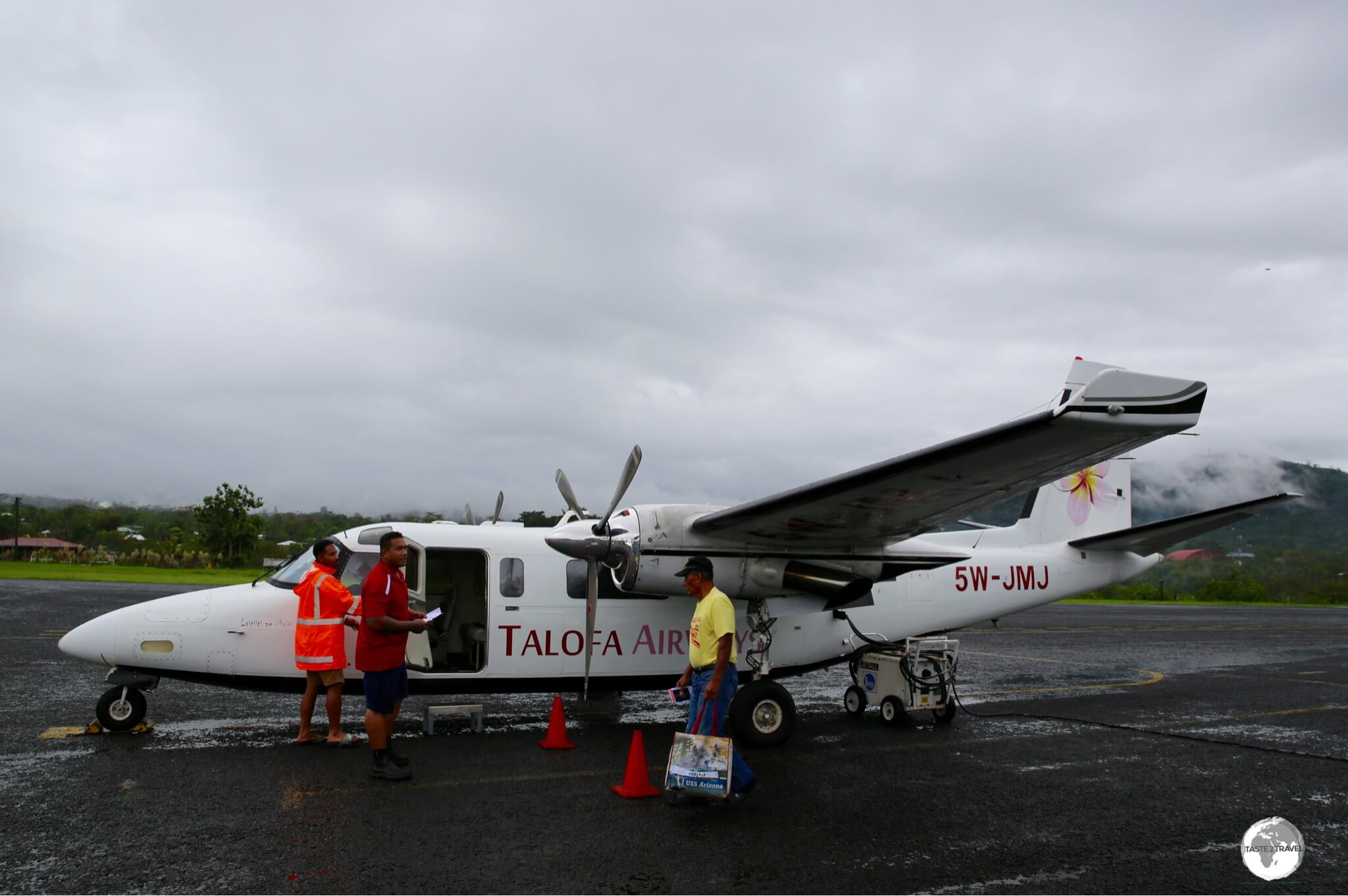
Departing from Fagali’i Airport (Samoa) for Pago Pago (American Samoa) on Talofa Airways.
Fagali’i serves as the hub for inter-island flights between Samoa and American Samoa (please refer to my American Samoa Travel Guide for more details on this interesting destination), which are provided by Talofa Airways and Samoa Airways.
In addition to the American Samoa flights, Talofa also provide a weekly service to Tonga every Friday.
Fagali’i Airport Transport
Public buses pass the airport during daylight hours, with a journey time of about 10 mins to the capital. Airport taxis are always available from the rank outside the terminal and charge WST10 to anywhere downtown.
Sea
Intra-Island Ferry

The MV Lady Naomi, seen here in Apia harbour, was out-of-service due to ongoing maintenance during my visit.
The Samoa Shipping Company operates the MV Lady Naomi passenger ferry, which normally sails between Apia and Pago Pago once a week. At the time of my visit (October 2018), the fine lady was out-of-service due to ongoing repairs.
Cruise Ship
Samoa lies well off the regular Pacific cruise ship circuit with just eight ships scheduled to arrive in 2018. You can check the current schedule on the crew-center.com website.
Getting Around

A Samoan boy, waiting for his bus to depart from Apia.
Air
There are no internal air services in Samoa. Neighbouring Savai’i is 15 km from Faleolo airport and can be reached by frequent ferries, which depart from the dock a short distance west of the airport.
Public Buses

The colourful buses of Samoa are very funky.
Affordable, open-air, public buses run frequently during daylight hours on both islands and are the preferred mode of transport for most Samoans. I would nominate the vibrantly painted Samoan buses as the grooviest in the entire Pacific region.

A shiny hood ornament on a Samoan bus.
Mostly privately owned, the chassis and engines of these six-ton diesel Toyota’s are imported, but the bodywork is made locally by hand then painted with the most colourful of designs.
These icons of the road are slowly disappearing as Toyota have stopped producing the chassis and modern, air-conditioned, Korean-made buses, offer a more comfortable journey.

Food vendors at the bus terminal in Apia.
All buses on Upolu depart from the Fugalei Bus Depot in Apia. It’s here you’ll find hordes of Samoans lining up to catch their bus, and if full there’s always someone whose lap you can sit on. On Savai’i, the bus terminal is at the market in Salelologa.
Current bus fares are listed on the Land Transport Authority website.

Samoa buses are adorned with fantastic artwork.
Taxi

One of many taxi ranks in Apia.
My favourite kind of cities are those where there is a healthy ratio of taxis to passengers. In the case of Apia, supply outstrips demand, with full taxi ranks to be found on every block of the downtown area.
The huge number of taxis are literally the fruits of labour from itinerant Samoan labours who spend time each year working on fruit farms in New Zealand and Australia. Upon returning home, with a pocket full of cash, buying a taxi is the easiest way to create your own business. Unfortunately, too many people have had the same idea which has led to a glut in the taxi market.
With so much competition, fares are very reasonable with destinations around town averaging WST$5, while the 45 minute journey to Faleolo International Airport costs WST$60. Current taxi fares are listed on the Land Transport Authority website.
Rental Car

My rental car on scenic Upolu island.
The license plates of all rental cars in Samoa are prefixed with an ‘R‘. Every visitor to Samoa who wishes to rent a car must apply for a Temporary Driver’s Licence which costs $20 tala for one month and $40 tala for two months. The license is normally issued by the rental company at the time of rental.

Samoan license plate.
On the 8th of September, 2009 Samoa become the first country since the 1970s to change the side of the road on which cars are driven. At 6 am on that morning, sirens sounded and drivers were told to move from the right side to the left. A two day holiday was declared to minimise traffic which resulted in no accidents.

Touring picturesque Savai’i Island in my rental car.
There are plenty of car rental agents in Samoa with the following maintaining an office at Faleolo International Airport:
Other rental companies in downtown Apia include:
I rented an excellent Hyundai Creta through my hotel, Talofa Inn, for WST$100 per day.
Ferry
The Samoa Shipping Corporation provide a regular car and passenger ferry service between the two islands of Upolu and Savai’i. You can book tickets, check the current schedule and fares on their website.
Tickets can also be purchased from their office in downtown Apia (next to Paddles restaurant) or from the ferry terminals on either island.

There are two ferries which make the crossing between Upolu and Savai’i, with the Lady Samoa being the larger and more comfortable of the two.
If you are travelling by car, you should book as far in advance as possible as most ferries are sold out in advance.

The smaller ferry which connects Upolu and Savai’i Islands.
That’s the end of my Samoa Travel Guide.
Safe Travels!
Darren
Follow me on Instagram:
[instagram-feed feed=1]
Further Reading
Other travel reports from the Pacific region:
Samoa Travel Guide Samoa Travel Guide Samoa Travel Guide Samoa Travel Guide Samoa Travel Guide Samoa Travel Guide Samoa Travel Guide Samoa Travel Guide Samoa Travel Guide Samoa Travel Guide Samoa Travel Guide Samoa Travel Guide Samoa Travel Guide Samoa Travel Guide Samoa Travel Guide Samoa Travel Guide Samoa Travel Guide Samoa Travel Guide Samoa Travel Guide Samoa Travel Guide Samoa Travel Guide Samoa Travel Guide Samoa Travel Guide Samoa Travel Guide Samoa Travel Guide
Author: Darren McLean
Darren McLean is an Australian, full-time, digital nomad who has spent 37 years on a slow meander around the globe, visiting all seven continents, 192/ 193 UN countries and 245/ 251 UN+ countries and territories.
He founded taste2travel to pique one’s curiosity and inspire wanderlust.


